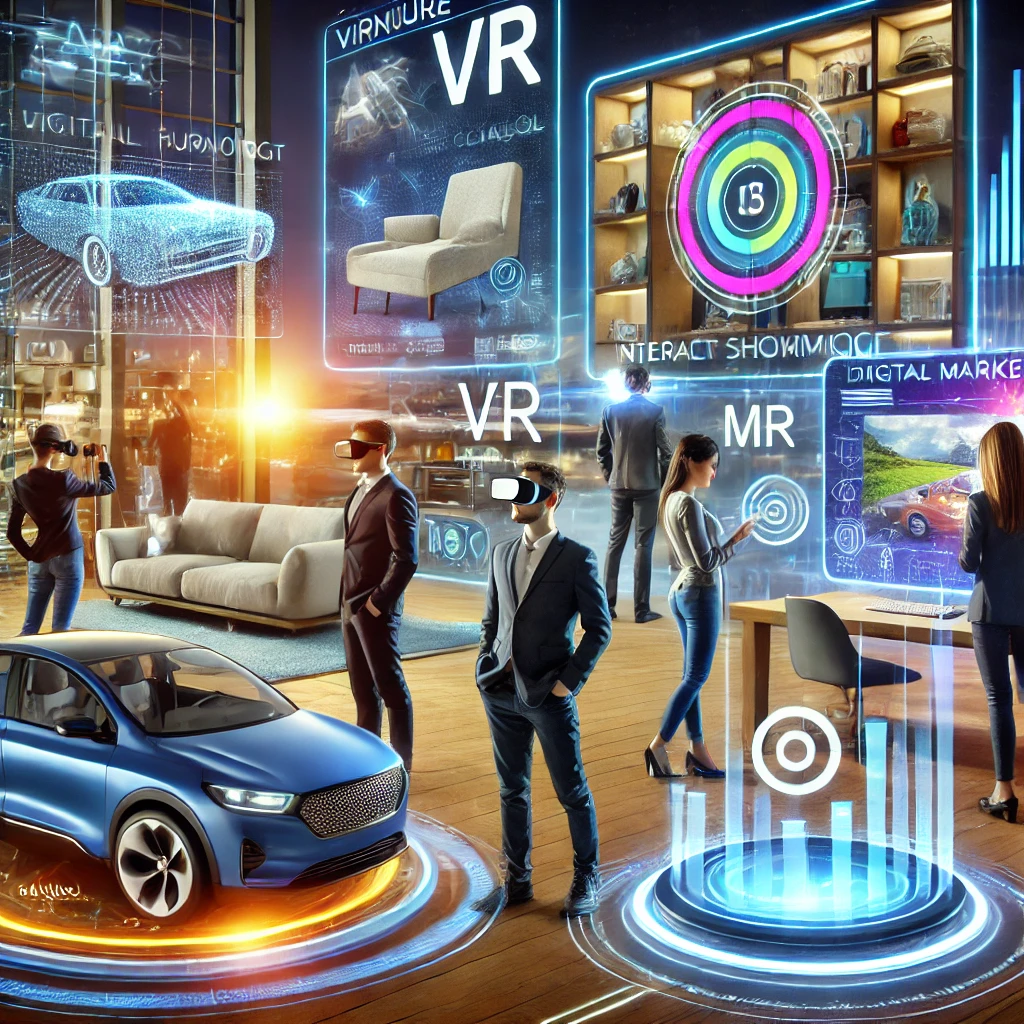Augmented Reality (AR), Virtual Reality (VR), and Mixed Reality (MR) are reshaping the way brands connect with customers. By blending the digital and physical worlds, these technologies offer immersive, interactive experiences that captivate audiences like never before. From virtual product demonstrations to augmented shopping experiences, businesses are leveraging AR, VR, and MR to boost engagement, enhance brand loyalty, and stand out in competitive markets. In this article, we’ll explore how these cutting-edge technologies are revolutionizing marketing, backed by real-world examples and actionable insights.

Key Benefits of Immersive Tech in Marketing
Immersive technologies like AR, VR, and MR are game-changers in marketing, offering several impactful benefits:
- Boosts Engagement and Interactivity:
These technologies create highly engaging campaigns that capture attention and keep audiences interested longer. For example, AR filters on Instagram encourage users to interact directly with branded content. - Enhances Product Visualization:
Customers can see and interact with products virtually, improving decision-making. IKEA’s AR app, IKEA Place, lets users visualize furniture in their homes before purchasing. - Increases Customer Retention and Brand Loyalty:
Immersive experiences leave a lasting impression, helping brands stand out. VR storytelling in tourism, such as 360-degree virtual tours, transports users, creating memorable interactions.
These benefits are driving businesses to adopt AR, VR, and MR as essential components of their marketing strategies.
Examples of AR in Marketing
Augmented Reality (AR) bridges the gap between the digital and physical world, providing engaging and practical marketing solutions. Here are some standout examples:
- AR Filters for Social Media Campaigns
Brands create interactive filters on platforms like Instagram and Snapchat to boost engagement.
Example: Disney’s AR filters for movie promotions allow users to transform into characters, making the experience shareable and fun. - Try Before You Buy Experiences
AR apps let customers preview products in real-world settings, improving confidence in purchases.
Example: Lenskart’s AR tool enables users to try on glasses virtually, saving time and enhancing satisfaction. - Interactive Product Packaging
AR enhances packaging by linking it to immersive content via QR codes or apps.
Example: Coca-Cola’s AR campaign transformed cans into portals to festive 3D animations, elevating brand interaction.
These examples highlight how AR is redefining customer experiences while driving marketing success.
Examples of VR in Marketing
Virtual Reality (VR) provides fully immersive experiences that allow customers to engage with brands in a dynamic and memorable way. Here are some practical applications of VR in marketing:
- 360-Degree Virtual Tours
Businesses use VR to offer realistic virtual tours, providing customers with an in-depth experience without needing to visit physically.
Example: Real estate companies like Matterport create virtual property walkthroughs, helping buyers explore homes remotely. - Immersive Storytelling for Brand Campaigns
VR transforms traditional advertising into storytelling adventures that emotionally connect with audiences.
Example: Tourism Australia’s VR campaign lets users experience snorkeling in the Great Barrier Reef, inspiring travel plans. - Virtual Product Demonstrations
VR showrooms offer customers a hands-on feel for products in a virtual setting.
Example: Audi’s VR Experience allows potential buyers to explore car interiors and test features without visiting a dealership.
These VR applications showcase how brands can create lasting impressions and increase conversion rates with immersive experiences.
Examples of MR in Marketing
Mixed Reality (MR) combines the best of AR and VR, enabling real-time interaction between the physical and virtual worlds. Here are some powerful examples of MR in marketing:
- Interactive Product Demos at Events
MR creates immersive experiences during trade shows and brand activations, allowing users to interact with virtual objects in physical spaces.
Example: Microsoft HoloLens showcases products like furniture or electronics, enabling customers to explore features in a mixed reality environment. - Retail Innovations
MR enhances in-store shopping by blending virtual elements with physical spaces.
Example: Sephora’s Magic Mirror lets users virtually try on makeup shades in real-time, streamlining the buying process. - Engaging Brand Experiences
MR campaigns engage customers through live experiences, creating buzz and fostering emotional connections.
Example: Pepsi’s MR bus shelter campaign amazed passersby with dynamic 3D visuals of alien invasions and roaring tigers, creating a memorable brand moment.
These MR applications provide unique ways to captivate audiences, making it a valuable tool for innovative marketing strategies.
Quick Challenges of Immersive Technologies in Marketing
While AR, VR, and MR offer incredible potential, implementing these technologies in marketing comes with a few challenges:
- High Implementation Costs
Developing and deploying immersive experiences can be expensive, especially for small businesses. Advanced hardware and software often require significant investment. - Accessibility and User Adoption
Not all customers have access to devices like VR headsets or high-performance smartphones needed for AR experiences, limiting reach. - Technological Limitations
Complex experiences may face technical issues, such as glitches, long loading times, or device compatibility, which can frustrate users. - Risk of Overcomplication
Sometimes, immersive campaigns can overcomplicate the user journey, distracting from the core marketing message.
Despite these challenges, the increasing affordability of technology and growing user familiarity with immersive tools make AR, VR, and MR more accessible for businesses.
Future Possibilities of Immersive Technologies in Marketing
The future of AR, VR, and MR in marketing is bright, with emerging trends and advancements reshaping how businesses engage with their audiences. Here’s what lies ahead:
- Integration with AI for Hyper-Personalization
Combining AI with immersive technologies will enable brands to deliver tailored experiences. For instance, AR mirrors in retail could analyze customer preferences in real time and suggest personalized product recommendations. - Hybrid Shopping Experiences
Mixed Reality will redefine e-commerce by blending online and offline shopping. Imagine virtually trying on clothes in an MR fitting room while receiving live assistance from a virtual store associate. - Virtual Influencers and Brand Ambassadors
Virtual influencers powered by AR and AI are already collaborating with brands to create unique, engaging campaigns. This trend is expected to grow, offering a cost-effective alternative to traditional influencers. - Immersive Advertising in the Metaverse
As the metaverse expands, brands will create VR-driven ad campaigns in virtual worlds, offering unparalleled engagement and direct interaction with digital avatars. - Cost Reduction and Accessibility
Advancements in technology will reduce the costs of hardware like VR headsets, making these tools accessible to small businesses and consumers alike.
References for Further Reading
- The Future of Augmented Reality in Marketing – Forbes
- How Virtual Reality is Revolutionizing Marketing – TechCrunch
- Mixed Reality in Business: A Game-Changer for Marketers – Microsoft Blog
- Top Trends in AR/VR Marketing – Think with Google
These resources will help you dive deeper into how immersive technologies are shaping the future of marketing.

Paul Graham, a renaissance man of the tech world, is a computer scientist, Lisp advocate, and prolific blogger. His insightful essays explore various tech and startup topics, making him a thought leader in the industry.